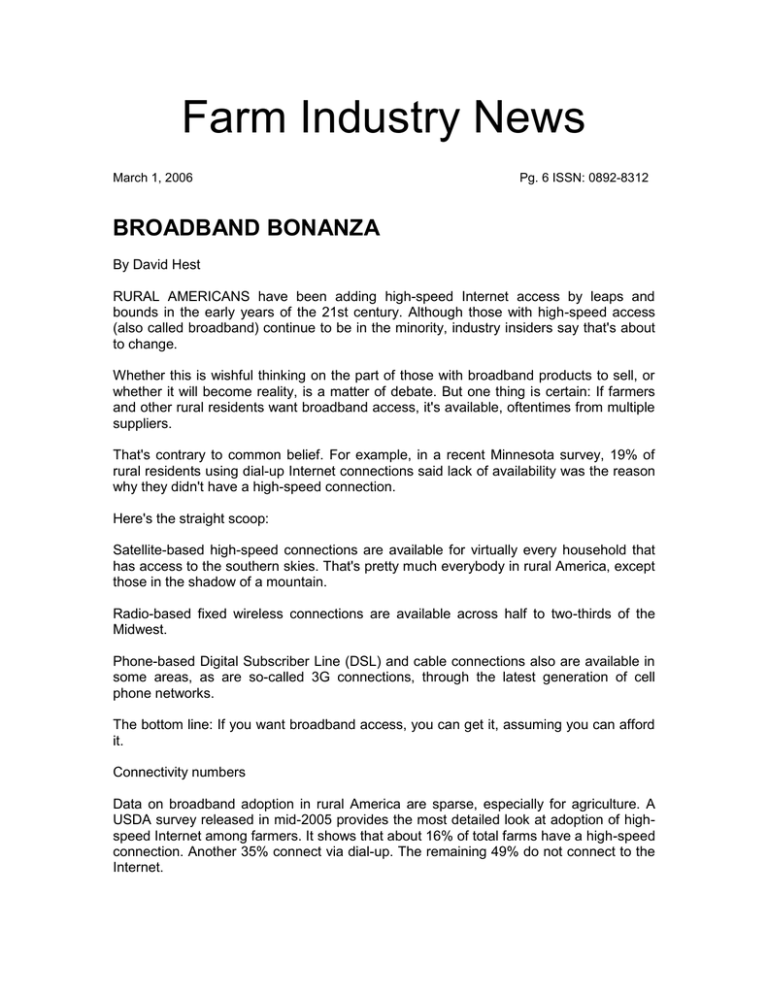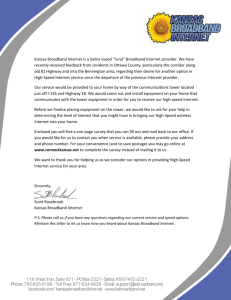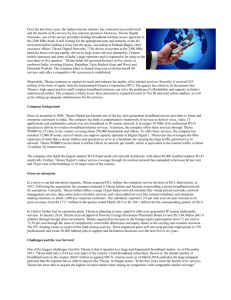Farm Industry News BROADBAND BONANZA
advertisement

Farm Industry News March 1, 2006 Pg. 6 ISSN: 0892-8312 BROADBAND BONANZA By David Hest RURAL AMERICANS have been adding high-speed Internet access by leaps and bounds in the early years of the 21st century. Although those with high-speed access (also called broadband) continue to be in the minority, industry insiders say that's about to change. Whether this is wishful thinking on the part of those with broadband products to sell, or whether it will become reality, is a matter of debate. But one thing is certain: If farmers and other rural residents want broadband access, it's available, oftentimes from multiple suppliers. That's contrary to common belief. For example, in a recent Minnesota survey, 19% of rural residents using dial-up Internet connections said lack of availability was the reason why they didn't have a high-speed connection. Here's the straight scoop: Satellite-based high-speed connections are available for virtually every household that has access to the southern skies. That's pretty much everybody in rural America, except those in the shadow of a mountain. Radio-based fixed wireless connections are available across half to two-thirds of the Midwest. Phone-based Digital Subscriber Line (DSL) and cable connections also are available in some areas, as are so-called 3G connections, through the latest generation of cell phone networks. The bottom line: If you want broadband access, you can get it, assuming you can afford it. Connectivity numbers Data on broadband adoption in rural America are sparse, especially for agriculture. A USDA survey released in mid-2005 provides the most detailed look at adoption of highspeed Internet among farmers. It shows that about 16% of total farms have a high-speed connection. Another 35% connect via dial-up. The remaining 49% do not connect to the Internet. In other words, the survey shows that, among the 51% of farmers with an Internet connection, 31% of them have a broadband connection and 69% use a dial-up connection. (For a detailed look at which farmers tend to have high-speed Internet access, and how they use their online connection, see the accompanying story "Who's online?" page 20.) Although the percentage of farmers with high-speed connections is relatively small, it appears to be growing rapidly. Surveys of rural households conducted by the Pew Internet and American Life Project show that broadband use grew more than sixfold from 2000 to 2003, an average annual increase of 185%. The latest Pew survey showed that broadband use in rural areas stood at 19% in 2003, having grown from 3% of households in 2000. The survey data show that broadband adoption in rural areas significantly lags adoption in urban and suburban communities. But it also shows that rural residents have been playing catch-up; in 2003, 36% of rural residents who connected to the Internet bought broadband services, whereas 32% of their urban and suburban counterparts did so. Ready for takeoff? "We are about to see a big leap," predicts Kip Pendleton, president and co-CEO of Agristar Global Networks, which markets a satellite-based broadband service to agricultural producers in 48 states. Pendleton says adoption of high-speed Internet is following the same pattern as adoption of other technologies. Using terminology first developed by Iowa State University to describe adoption of hybrid seed corn, he says that "innovator" (2.5% of population) and "early adopter" (13.5% of population) farmers make up most of the current broadband users. The market has just moved into the "majority" (68% of the population) part of the adoption curve, which suggests explosive growth and use of broadband, Pendleton says. "When we used to ask farmers attending the Farm Progress Show or Husker Harvest Days whether they had broadband, they didn't know what we were asking," he says. "Now people are saying they don't have broadband, but they know they need it. Now the question is, Do they know they can get it?" "Demand is continuing to grow," says Darren Siekman, senior vice president of DTN SpeedNet, which provides radio-based high-speed Internet services to about 8,000 subscribers in 242 communities in several Midwestern states. "In general, we continue to see 15% or higher growth on an annual basis." High-speed options Internet access is considered to be high speed if it operates above the maximum speed possible with a dial-up telephone connection, or 56 kilobits per second (kbps). In many rural areas, effective maximum dial-up speeds are in the 28- to 40-kbps range. High-speed Internet connections generally operate in a range of 300 kbps to 4.5 megabits (1,000 kbps) (mbps), depending on the technology and the service option. That's 10 to 150 times faster than a 33-kpbs dial-up connection. In addition to offering higher speed, these services are always connected, so you don't have to establish a connection each time you want to use the Internet or check your email. And you don't have to tie up the telephone line when you use the Internet. These are the major high-speed Internet options available in rural America. Fixed wireless Fixed wireless services are available on a community-by-community basis. By some estimates, half to two-thirds of the households in the Midwest have fixed wireless coverage, and this percentage is expected to grow. This technology uses 2.4- or 5.8gigahertz radio signals to connect subscribers within a four- to six-mile radius of a central antenna, although multiple antennas can stretch the coverage area. Fixed wireless download speeds range from 300 kbps to 4.5 mbps, depending on the provider and service option. Prices generally range from $30 to $60/month for basic service, which often includes several e-mail addresses. Installation and equipment costs typically are in the $300 to $500 range, depending on program details and contract terms, although some wireless providers offer start-up costs as low as $99. To qualify for fixed wireless service, the view between the central antenna and your antenna location must be unobstructed. There is no central directory of fixed wireless providers, although some Web site listings appear to be fairly comprehensive. One such listing can be found at http://www.onelasvegas.com/wireless/compare.html. Satellite Satellite services are available to virtually anyone in the U.S. with a clear view of the southern sky. Two satellite services - DirecWay (http://www.direcway.com) and Wild Blue (http://www.wildblue.com) - are competing most aggressively for customers. Both are marketed by multiple companies. A third company, Starband (http://www.starband.com), also provides satellite services but appears to have scaled back marketing efforts. Many members of the National Rural Telecommunications Cooperative (http://www.nrtc.org), whose members include more than 1,000 rural utilities and affiliates in 46 states, sell either DirecWay or Wild Blue services. Satellite equipment and services also can be purchased through Radio Shack and other electronics stores. Download speeds average 500 to 700 kbps for basic service plans, but speeds up to 1.5 mbps are available. Agristar Global Networks (http://www.agristar.com or 888/777-0440) is focused strictly on the ag and food industries and uses satellite services provided by DirecWay's parent company. Its service includes a news, weather and markets information package, including the Hightower Report. Its $49.95/month charge is comparable to charges by satellite competitors not offering this agriculture-focused information package. The typical monthly cost for a broadband satellite connection is $50 to $70. A satellite dish and installation typically cost $400 to $600, although special offers can reduce costs. Installation costs are down dramatically from three years ago, when costs ran $600 to $1,100. DSL A Digital Subscriber Line (DSL) uses the same telephone line that carries telephone service to simultaneously provide high-speed access. DSL is available primarily in urban areas because the technology works within about three miles of a telephone company switching center or central office. Innovative rural telephone companies in Iowa and elsewhere have extended DSL service by installing hub-and-spoke systems that effectively extend the DSL coverage area. Others have combined DSL and fixed wireless technologies to provide coverage to 90% or more of their service areas. DSL download speeds typically are in the 400-kbps to 5-mbps range, depending on the service option. Monthly costs are in the $35 to $50 range for basic plans. Equipment typically costs $60 to $75. Contact your local telephone company to see if DSL service is available. 3G cellular 3G is an umbrella term that refers to third-generation wireless networks designed to deliver broadband speeds to cell phones and other mobile devices. But 3G networks also are compatible with computers with an appropriate wireless card, which sells for about $100. These networks offer speeds of 400 to 700 kbps, comparable to other broadband alternatives. There's a catch: 3G towers are concentrated in and near major metropolitan areas. The three main providers of 3G services are Cingular/AT&T, Sprint and Verizon. Verizon Wireless has coverage in about 170 cities. Unlimited service costs about $60/month with a call plan. Sprint's Mobile Broadband service also costs $60/month and is available in 212 cities and along major highways. The BroadbandConnect service from Cingular Wireless is currently available in 16 major metropolitan areas and costs $80/month for unlimited access. Cingular also provides a slower 2.5G cellular technology available over broader areas, including along many major highways. With a speed of about 90 kbps, it is faster than dial-up but far slower than typical broadband speeds. All three providers are rapidly expanding their networks, so stay tuned, especially if you are near a metropolitan area or along a major highway. You can contact Verizon Wireless at 800/256-4646 or visit http://www.verizonwireless.com. For information about Cingular BroadbandConnect, visit http://www.cingular.com/midtolarge/umts. Sprint Mobile Broadband information is available at http://www.sprint.com/business/products/products/wirelessHighSpeedData.jsp.

